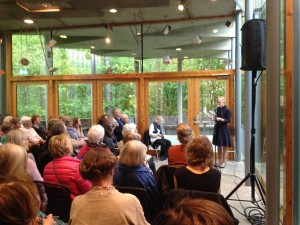Our research team is not only mediating between two periods, the nineteenth century and today, but between groups of people that may often have very different approaches to literature. From the start of the HERA TTT project, we have focused on the idea of ‘meeting your mother’: to let modern readers and authors be introduced to, or reminded of, the women writers of the past, and relate to them in a personal way. For The Norwegian Literary Festival on May 28th this year, we deliberately asked professional authors – novelists and poets – to respond to the old authors, because we wanted the creative response as well as our own academic observations. One of the three authors (Skomsvold), indirectly points to the gap that often exists between the two worlds. She recounts how she felt daunted by the task of writing a letter to Amalie Skram, imagining professors of literature and literary critics watching over her shoulder, with their extensive knowledge (or so she assumes), blocking her ability to write freely, until she started thinking what she really wanted to say to Skram.
Our programme at Lillehammer, therefore, was composed as two interdependent parts: the presentation of some research results on our literary foremothers, for instance the number of Norwegian women found in other countries a hundred years ago. And secondly, the modern authors’ responses to some of these women. We wanted to build bridges over the mentioned gap between the academia, readers and authors, and we have, in a modest way, managed to do so.
The three selected authors for the Norwegian event represent different age groups: Thorvald Steen is 61, Mona Høvring 53 and Kjersti A. Skomsvold 35. These three had been asked to write letters to three foremothers: Sigrid Undset, Camilla Collett and Amalie Skram, respectively. They had a very keen audience: queuing outside to get into the event, they crammed the room, with people standing at the back. The audience also rewarded them with much heartfelt applause afterwards. Meeting contemporary, successful, much talked of, authors was obviously popular among the festival audience, some of them coming forward to have their copies signed afterwards.
When I talked and wrote to them afterwards, all three authors expressed sheer enthusiasm for the task that had been given them. Steen wished for a second commission, so that he could have spoken about Skram as well as Undset. Skomsvold writes: ‘it was an incredibly great event to participate in’; ‘I’ve had many positive comments, for all three contributions, it was fun to see that we had solved the task so differently.’ And, indeed, they did.
Studying their portraits, however, they all come to resemble their respective foremothers in an uncanny way, as if the artistic connection becomes as traceable in their faces as a genetic one would have been.
